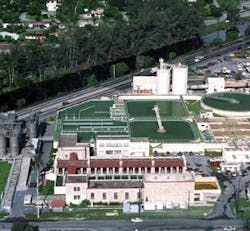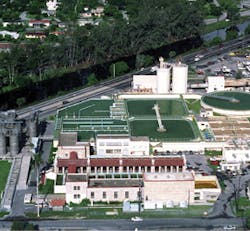Inspiring by Example: The Water Use Efficiency Plan
The Miami-Dade Water Use Efficiency Program–developed by the Miami-Dade Water and Sewer Department (WASD)–is an operational and policy-based program packed with Best Management Practices (BMPs) aimed at dealing with not only South Florida’s ongoing drought issues, but also in response to the capping of its main water source, the Biscayne Aquifer. Ultimately, the goal of the program is to promote the idea that water conservation itself is a way of developing alternative water supplies, especially in light of the current state of the area’s aquifer.
Since the first building was erected in South Florida, the aquifer has served as the region’s drinking water source, but it has reached its limit. As a result, the South Florida Water Management District (SFWMD) has instructed water utilities that South Florida growth has to be accommodated from other sources.
“The Everglades needs the water, and it has been decided that the environment will keep the natural sources and alternative water sources will be needed for urban growth,” says Maribel Balbin, Water Use Efficiency Program manager for WASD.
Projected growth for the entire county by 2027 is 3.1 million, compared to its present population of 2.5 million. The population served by the WASD is 2.2 million, with a projected growth of 2.7 million. (Other municipalities within the county serve the remainder of the population.) The projected growth means a demand of 75 million gallons per day (mgd) more than is used today.
Miami-Dade County was the first in its state to be asked to do long-range planning based on alternative water sources, just as the county’s water treatment plant was preparing to accommodate the next 20 years of growth by continuing to pump out of the Biscayne Aquifer. In November 2007, the SFWMD issued the WASD a 20-year water use permit stacked with 58 conditions, including a goal-based water conservation program.
“When you get the new marching orders, you wonder where else your water is going to come from,” says Balbin. “Our permit is one of the most conditioned permits ever, to my understanding.
The Miami-Dade Water and Sewer Department promotes the idea that water conservation itself is a way of developing alternative water supplies, especially in light of the current state of the area’s aquifer.
“We were told that of the next 75 million gallons a day needed for growth between now and 2027, 19.8 million gallons have to come out of conservation, and 14.8 million gallons have to come out of looking for the source of water losses,” she adds.
A leak detection program could take care of the latter concern, but to address conservation meant pulling together a variety of BMPs that would help achieve the needed water reduction goal of 19.8 mgd.
The Water Use Efficiency Program staff went to work to develop the Miami-Dade Water Use Efficiency Plan, which features several projects, including:
- A high-efficiency toilet (HET) full retrofit for senior citizens and residents who meet the federal criteria for low-income households. In its first year this program had 774 participants, saving 49,536 gallons per day. The program received a Water Conservation 2007 Award for Excellence by the Florida Section of the American Water Works Association (FSAWWA).
- An HET rebate project offering residents a $100 rebate to replace water-wasting toilets with new HETs that use less than 1.3 gallons per flush. The project had 750 participants in its first year, with a water savings of 21,750 gallons per day, and also won a 2007 Water Conservation Award from FSAWWA.
- Water efficient landscape and irrigation evaluations targeting homeowners associations with large landscaped irrigation areas. In addition to the audit, the project includes training landscape personnel in the principles of efficient irrigation to increase water use efficiency.
- A showerhead exchange and retrofit kit that provides high-efficiency showerheads to Miami-Dade County residents. Those who exchange their old showerheads can save up to 50% on their indoor water usage. Last year, 8,117 showerhead kits were distributed, representing a water savings of 381,499 gallons per day.
- A green lodging and restaurant program that encourages restaurants and lodging facilities to reduce water consumption, protect air quality, and reduce waste. Participating restaurants are provided with low-flow pre-rinse spray valves; placards for restaurants, indicating water will be served upon request, and training for housekeeping staff; and printed materials, encouraging lodging guests to participate in a linen reuse program.
- Participation in Water Education for Teachers in the City program, an urban environmental education program of the Council for Environmental Education
- A program providing classroom materials to teachers, who also can earn continuing education credits. Last year, 100 teachers participated in the program, which reached 6,134 students.
- County-owned facility audits and water restriction advisories
In its first year all of the projects exceeded the program’s goals, with the most popular one being the showerhead exchange program. As the program took hold, water use numbers began to decline. In 2006, the per capita water consumption was 157 gallons per person per day. By contrast, in September 2008–nearly a year into the program’s implementation–water consumption was reduced to 143 gallons per person per day, less than the projected 148 gallons per person per day for 2027.
The WASD is the local sponsor for “WET in the City,” an urban environmental education program of the
Council for Environmental Education that focuses on protecting and conserving water resources.
The WASD has three regional water treatment plants that handle 440 mgd and five small treatment plants that produce an additional 12 mgd. Water is transmitted through 7,225 miles of water mains. The system has more than 418,000 retail service connections and 15 municipal wholesale customers. It has a $551-million operating budget. Like most places throughout the US, the infrastructure of Miami-Dade’s water system is aging, and a capital improvement plan has been developed for its replacement and renewal. The conservation program enables a capital deferment by about 4.5 years. “We can defer costly infrastructure for alternative water supply if we continue to bank the water through conservation, because we can provide water for a new development today with the existing water,” says Balbin.
The conserved water reduces the need to develop alternative water supplies to meet future demands. “Our goal is to save as much water as possible through conservation so that we can avoid having to produce it at the anticipated much-higher cost in the future,” she says. “Conservation is the least-expensive alternative water supply source. By not using water, we are producing it in some sort
of way.”
At the end of the five-year period in 2011, the WASD will have to evaluate the entire program, which also will be reviewed by the SFWMD. The district’s 20-year plan encompasses five-year reviews. “The financial health of the utility and the impact of conservation would be beneficial from the standpoint of deferring very expensive capital projects,” says Balbin.
In March, Balbin’s office will give its first compliance report to the SFWMD. Set up like a scorecard, it breaks down all of the target goals, which her office has exceeded. “We are going to have more than 1.7 million gallons to put on the table for them, based on the fact that the program has been a lot more successful faster than we thought,” she says.
Political support gave teeth to the water use efficiency program, according to Balbin. The Miami-Dade County Commission directed the program’s development through an ordinance, and adopted subsequent ordinances and resolutions to strengthen its implementation.
Adopted by the Board of County Commissioners in April 2006, the Miami-Dade Water Use Efficiency Plan was a part of a larger effort to improve the management of traditional water resources, while encouraging the development of alternative water supplies. One code adopted by the county–effective January 2009–includes stronger new construction requirements. New buildings must have 1.2-gallons-per-flush toilets, 1.5-gallons-per-minute faucets and showerheads, as well as a requirement for multifamily buildings to be submetered. As a result, a home in Miami-Dade will use 31% less water.
“One of the unique things about my program is that it’s a policy-driven program,” says Balbin. “The County Commission has been involved from the beginning, so it has been a top-down rather than a bottom-up program. A lot of utilities have a problem when staff starts trying to put this together and get buy-in and support.”
There are 14 cities to which the county distributes water. Each city has its own distribution system, selling the water to their residents. “We also mentor them in developing their plans, and some BMPs they can implement to reduce their per capita use,” says Balbin. “We are determining what should be the right per capita for each of the utilities, so the savings we need to put on the table for the South Florida Management District comes from not only just the Miami-Dade Water and Sewer savings, but also a compilation of the 14 wholesalers, because it’s the same water–they just buy it from us.”
Some utilities have member governments to which they sell water, but have limited authority as to what they can ask of those cities, Balbin points out. “In our case, the county commission put an ordinance together that says all wholesalers have to develop a plan similar to the plan being required by the district for Miami-Dade County,” she says.
The county commission’s support has made a big difference in funding, Balbin points out. Water conservation is a program that takes spending money to save money. “Funding is necessary to address all of these issues,” says Balbin. “Some utilities can do that better than others depending on the size. We are a large utility, and we’ve been able to accommodate this cost, so in the end, it’s going to provide a benefit for us.”
The total annual budget for the Water Use Efficiency Program is $943,000 for project implementation and $270,000 for outreach and public information. Funding for the program’s conservation BMPs comes from the WASD operating and maintenance funds, and through grants from the SFWMD’s Water Savings Incentive Program. The program offers grants to homeowners associations, municipalities, and utilities through a competitive process. In the past few years, the WASD has been awarded more than $100,000. “You need to tell them how many gallons of water you are going to save through the program they are funding and provide the data, and they will reimburse you,” explains Balbin.
The WASD developed the plan using the Florida Department of Environmental Protection’s “Conserve Florida Water Conservation Guide,” a Web-based application for goal-based water conservation planning. The WASD was the first utility in Florida to use this guide. Balbin says prior to the current system, the SFWMD would require a water conservation plan from utilities at the time they applied for their consumptive use permit. The plan would outline measures without providing specific calculations or accounting procedures, she adds.
The Guide is a software application that allows a utility to assess its population, water demands, projections, a count of the homes in the community, and their age. Utility managers plug in data, and the software suggests effective BMPs and an estimated savings of gallons of water. In Miami-Dade’s case, the estimated savings was 1.7 million gallons, exceeding the goal of 1.5 million required by the permit. The software is free to all utilities. “Utilizing the Conserve Florida Guide to develop the plan provides the ability to calculate, account, and report every gallon saved through the selected BMPs and the flexibility to adjust those savings, depending on the specific needs of the utility,” says Balbin. “We report how many gallons of water we saved on a chart, on a quarterly basis, and how many of these best management practices we implemented. Some of it is simple–obviously, if you replace a toilet, it represents a savings of a specific number of gallons.”
A major component of the program is retrofitting single-family homes, adds Balbin. Thus, the program was developed with that in mind, incorporating landscape irrigation water use, home evaluations, and rebate programs. “They are our largest users–46% of our total water goes to single-family usage, and half of that goes to irrigation,” she says. “We’re looking forward now to the South Florida Water Management District making the rule of irrigating no more than two days a week permanent, because of the fact that we have been able to reduce our consumption, which obviously has to do with the fact that the restriction has been in place. We are totally focusing on retrofitting every single home in Miami-Dade County that does not have the right appliances and fixtures.”
While water reuse as conservation has become a popular option for water utilities throughout the nation, Balbin says most of the reuse in Miami-Dade County will be for recharging the Biscayne Aquifer. The county may, however, replace water it presently supplies to the Turkey Point Nuclear Generating Station with reclaimed water in the future, to retain potable water in the system, she says.
The County is in the planning stages for a pilot project utilizing reclaimed water in the town of Key Biscayne, FL, and a local park and golf course. Balbin attributes the water efficiency program’s quick success to timing: The region’s drought brought water conservation through water restrictions to the forefront of public awareness,
she says. “At the same time, we were able to introduce our new requirements and rebate program, so it was all at the right place at the right time,” adds Balbin. “The drought has raised the level of awareness of the residents to a point where our per capita use has dropped from 157 gallons to 143 gallons per person per day, as a result of water restrictions. Based on the effect of the drought, the education program, and the conservation program, being at 140 per capita per day today puts us 18 years before the projected reduction.”
Another byproduct of the water conservation program is energy efficiency. More than $13,000 was saved in reduced energy costs needed to draw water from the raw water wells, transmit it through pump stations, and further treat it. “When you compare your water bill to your electricity bill or other bills, people think water is inexpensive, and they don’t realize that by saving water, they are saving other types of energy costs,” says Balbin. “We’re trying to tie the water savings to the energy savings.”
Although area residents may only notice a relatively minor impact of water conservation on their water bills, they’re noticing savings in their electricity bills after buying washing machines for which they receive rebates. One of the challenges in executing the program is rooted in the area’s diverse demographics. The WASD must communicate in three languages: English, Spanish, and Creole. In analyzing its marketing efforts, the WASD found that Internet marketing generates the most response. The department also has marketed its program through radio spots and newspaper advertising. “Now what we find is that stores are promoting the program for us,” says Balbin. “If you’re going to buy a toilet or washing machine, they automatically give you my rebate form.”
The program also is promoted as an “on-hold” message when people call the county’s hotline for water restriction violations. The local media has given the program attention, which also contributes to the program’s success, says Balbin. However, she insists her department would have met its goals nonetheless. “We have to,” she says. “I know we need to do “˜so many’ toilet rebates, “˜so many’ retrofits on the senior citizens’ homes, and give away “˜so many’ showerheads a year to meet the 1.5 mgd at the end of the year.”
Balbin’s advice to other water utilities considering water efficiency programs is to find a template that helps identify the needs for the particular area. “They need to match a gallon per implementation of whatever it is that they do,” she says. “Being able to account for the gallons is the only way to prove a program works and have that accountability. In the end, that’s what gives you the credibility and the funding for it.”
An effective program includes both measures and BMPs, Balbin points out. A measure doesn’t give a gallon value, but serves another purpose, such as public education. “The program needs to concentrate on accounting for water and making sure the water is being used as efficiently as possible,” she says. “The days of wasting water are over, so we look at what can we do today to make sure we put another gallon back in the mix.”
The key is to take gallons out of circulation, says Balbin. “For a new program, you have to be able to put a number on how many gallons were saved today,” she says. “The program has got to be measurable and account for every gallon you save, or it won’t give you what you need.”



